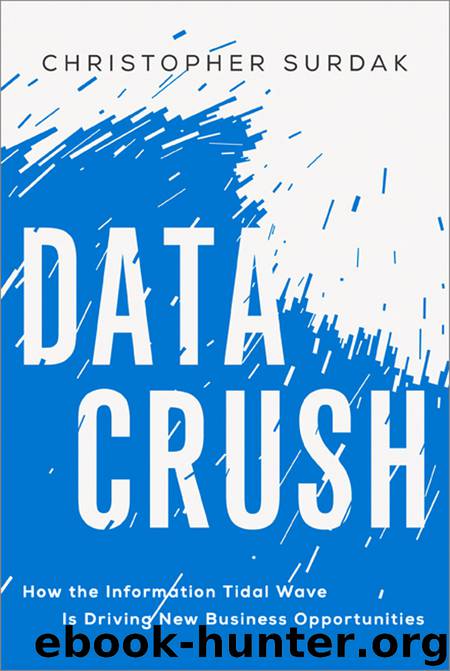Data Crush: How the Information Tidal Wave Is Driving New Business Opportunities by Surdak Christopher

Author:Surdak, Christopher
Language: eng
Format: epub
Publisher: American Management Association, AMACOM Division
Published: 2014-08-10T16:00:00+00:00
Source: Salesforce.com Annual Financial Reports3
FIGURE 11.2. Revenue Growth for Salesforce.com, 2005 to 2012
Companies like Vistaprint will close this gap very quickly, as such integration makes sense for all parties involved. Salesforce benefits by advancing its capabilities from Level 2 to Level 3 cloudification, their customers benefit by having more options for having business outcomes delivered by competitive third parties, and those third parties benefit by opening up their services to a marketplace that drives business to them. The value proposition is so sufficiently high that I would not be surprised if these sorts of services were established by Salesforce and other PaaS providers by the end of 2013. Hence, a key growth strategy for these PaaS providers is to create and support these outcome marketplaces themselves before their customers do it for them.
Outcome marketplaces then become a key differentiator between Level 3 and Level 4 cloudification. Following the previous example, Salesforce.com might create a marketplace for mailing list outsourcing where there are dozens of companies competing to deliver that outcome rather than just one. As Level 4 cloudification develops further, every business outcome that might come from the PaaS provider’s platform may be supported by an independent marketplace, each populated by other companies competing for the end customers’ business. At this stage, one of the primary value propositions of the platform owner is assisting customers in optimizing their business outcomes across these marketplaces. Indeed, orchestration of business outcomes across the platform’s supported processes will be the true differentiator of the platform. Because of quantafication, outcome marketplaces will develop whether the PaaS providers support them or not. As such, it will be in the platform providers’ best interest to foster the growth of these markets themselves, so that they can continue to control part of the process value chain.
Finally, PaaS providers will further advance their platforms to Level 5 cloudification, where the management of business outcomes across multiple outcome marketplaces will be optimized to the specific needs of each customer. At this point, PaaS providers will support fully customizeable, market-leveraged business processes that maximize the value delivered to end customers. As with quantafication Level 4, a Level 5 cloudified provider will also support competitive marketplaces for managing process and outcome exceptions. For example, if a company wanted to shop out the creation of a mass mailing and was concerned about the potential privacy concerns that might vary from state to state, it could find and engage an information privacy lawyer in a competitive marketplace for that exception.
The evolution of cloudification from Level 1 to Level 5 will take less than five years; such is the pace of business change in this day and age. This migration will occur both because of demand-side pressures from outsourcees, who are looking to improve their financial performance, and from supply-side pressures, as more and more middle-class workers are cut loose from their employers and begin looking elsewhere for gainful employment. Most of these people are likely to become freelance workers inside outcome marketplaces, performing their value-added work in small increments to whomever is the highest bidder on a given day.
Download
This site does not store any files on its server. We only index and link to content provided by other sites. Please contact the content providers to delete copyright contents if any and email us, we'll remove relevant links or contents immediately.
Influence: The Psychology of Persuasion by Robert B. Cialdini(4739)
The Miracle Morning by Hal Elrod(4677)
The Hacking of the American Mind by Robert H. Lustig(4342)
Pre-Suasion: A Revolutionary Way to Influence and Persuade by Robert Cialdini(4187)
Unlabel: Selling You Without Selling Out by Marc Ecko(3627)
Ogilvy on Advertising by David Ogilvy(3557)
Hidden Persuasion: 33 psychological influence techniques in advertising by Marc Andrews & Matthijs van Leeuwen & Rick van Baaren(3522)
Purple Cow by Seth Godin(3168)
Who Can You Trust? by Rachel Botsman(3112)
Kick Ass in College: Highest Rated "How to Study in College" Book | 77 Ninja Study Skills Tips and Career Strategies | Motivational for College Students: A Guerrilla Guide to College Success by Fox Gunnar(3100)
The Marketing Plan Handbook: Develop Big-Picture Marketing Plans for Pennies on the Dollar by Robert W. Bly(3007)
This Is Marketing by Seth Godin(2993)
I Live in the Future & Here's How It Works by Nick Bilton(2963)
The Power of Broke by Daymond John(2936)
The Tipping Point by Malcolm Gladwell(2873)
Building a StoryBrand by Donald Miller(2865)
The 46 Rules of Genius: An Innovator's Guide to Creativity (Voices That Matter) by Marty Neumeier(2820)
Draw to Win: A Crash Course on How to Lead, Sell, and Innovate With Your Visual Mind by Dan Roam(2756)
Market Wizards by Jack D. Schwager(2673)
